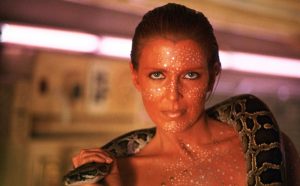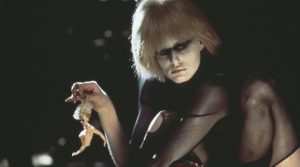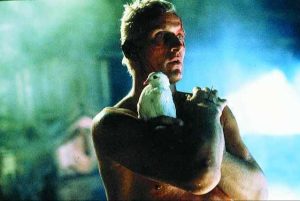
Directed by Ridley Scott
Based on the book Do Androids Dream of Electric Sheep by Philip K. Dick
Starring:
– Harrison Ford as Deckard
– Rutger Hauer as Roy
– Sean young as Rachel
– Daryl Hannah as Pris
– Edward James Olmos as Gaff
– William Sanderson as J F Sebastian
Back in the mid-nineties when I first heard about the new technology, “Digital Versatility Disk,” more commonly known as DVD, I wasn’t really all that excited about it in terms of cinema. I was just really into the idea of 4 gigs or more of data crammed onto a CD-sized piece of media for video games. Yes, I heard that you would be able to watch a movie in 12 different languages, but since I only speak English, I didn’t care. 100 different subtitles, so what? Deleted scenes?
Sort of appealing, but gimmickier than anything else. Commentary tracks? The last thing I ever want to hear is an actor telling me the meaning of anything without a director holding their hand. Listen to Sarah Jessica Parker try and get inside Mamet’s head on State And Main. Appalling. However, when I heard that Ridley Scott’s lifework, Blade Runner, was coming to DVD all enhanced and in Director’s Cut format, I bought a DVD player. [Ed Note: We think he might be telling the truth. We remember him saying something about Blade Runner being the first DVD he ever purchased.]


Blade Runner is simply a masterpiece. There is no other way to put it. Minus the story, which is a good Philip K. Dick one, the production design alone could hold my attention for two hours. The visuals are absolutely foreign without being beyond the realm of belief. Now that we are only sixteen years away from Los Angeles 2019, it probably would have been better if Scott has just said, “Los Angeles: The Near Future” or just “Los Angeles.” No matter. The designer, Lawrence G. Paull (License To Drive, Memoirs Of An Invisible Man), obviously shot his only load bringing the visuals in Blade Runner to life. And what a great load it was. Never did anything look all glossy (The Fifth Element) and frankly fake (Starship Troopers) like others in the genre often do.
Maybe the sense of reality is present because Scott chose to make a film noir sci-fi flick where the sets are actually part of the plot/cast rather than just an exercise in effects/big budgets. The point is, like 2001 and the three good Star Wars films, now more than twenty years on, Blade Runner, visually speaking, has stood the test of time. Sure, the uber hi-tech micro-cassette recorder is a gaffe, and the cars look silly, but almost every other aspect of the film is not only beautiful, but coming true.
There has been much hoopla made about the fact that the original theatrical release of Blade Runner had more than a hearty helping of voiced-over narration from Harrison Ford. According to the legend, Scott shot the movie without the narration, but the studio guys thought that me and you would be too dumb to understand what was going on. While this is no doubt absolutely true, the lack of narration does leave out a few cool little tidbits. Like the fact that the people of LA circa 2019 speak some sort of Esperanto comprised of English, Spanish, German and Japanese.
Nerds who read Do Androids Dream of Electric Sheep (Charles F.) will no doubt already know this. However, if the first Blade Runner you see is the Director’s Cut, you’ll have no idea. Does it really matter? No. I actually enjoy the absence of Ford’s narration, but I wonder if I had never seen the theatrical release how I would feel. No matter. Very shortly a Special Edition Director’s Cut 3 Disk DVD is coming out which will have both the Theatrical and Director’s Cut editions of the film. I’ll be buying it. [Ed Note: The Special Edition will also feature a new digital print and a remixed 5.1 score. Also, we’re nerds.]


Another aspect of the mythology surrounding the film is whether or not Ford’s character, the Blade Runner Deckard, is indeed himself a “replicant.” (Replicants are really well-crafted androids that in their latest iteration are not only stronger and quicker than humans, but just as smart, too. Maybe even smarter. Oh, and they are illegal here on earth because they kill humans and in turn are hard to kill. Blade Runners hunt and “retire” replicants.) Well, Scott went out and ruined all the mystery when he sat down in an interview and said, yes, Deckard is a replicant. Which sort of takes a lot of fun out of the movie for me. The speculation — listening to the little clues, watching for tiny details — made the film vastly entertaining. Sort of that old classic,
“Was it all a dream?” The Director’s Cut added a scene where Deckard is dreaming of a unicorn. At the end of both versions of the film, Deckard picks up an origami unicorn that Gaff (Olmos) had left inside his (Deckard’s) apartment. Originally, the symbol of the unicorn was a mystery. Now it is plain as day. Still, if you had never before pondered the question of whether or not Deckard was in fact not really human, it is a nice touch. Look, if you are hunting something faster, stronger and smarter than humans, what is the best tool for the job? Right…
My favorite scenes involve Rutger Hauer (Blind Fury), who also apparently completely shot his load doing Blade Runner. Actually, he was quite good in Clooney’s Confessions of a Dangerous Mind. (I have a theory that the career of anyone who appeared in a movie alongside Harrison Ford pre-1990 was cursed. See Mark Hammil, Carrie Fisher, Karren Allen, Kelley McGillis, Sean Young, Betty Buckley, etc.) In one scene, Rutger (and the incredibly under-appreciated Brian James–see Cabin Boy) confronts the man who made his eyes. Remember, Rutger is playing Roy Batty, a Nexus-6 replicant.
Therefore, someone created his eyes. Yes, there is an underlying religious element about meeting one’s maker (contrast Scott’s handling of this theme with the out and out clunkiness of how Lucas did it with C3P0 and Anakin in the latest Star Wars disaster), but there is another theme present as well. One that points to the dangers of runaway science.

My absolute favorite scene is when Roy actually confronts his maker, the mad/evil billionaire genius Tyrell, who actually built Roy’s mind. Just a brilliant scene. I have read other reviews of this movie where it is stated that Roy killing Tyrell is dumb, why would man kill God, etc. But I think the demicide/patricide is flat-out brilliant. Astonishingly brilliant. When confronted with God’s impotence, Roy actually does the sensible, Oedipal thing. Kill the bastard! (Oh, because they are so dangerous, replicants only have a four-year life span. Roy and his compatriots want more life. Me, too.)
The ending, where Rutger is chasing Ford around J F Sebastian’s loft, is also quite good, if not a little tacked on. Especially so in the Director’s Cut where the unnecessary–but fun–violence has been removed. Though I must point out that Roy driving a spike through his palm was a bit heavy-handed and probably too religious. After killing Tyrell, it would seem to me that Roy really has nothing left to prove. Or to do. He obviously has nothing to lose.
The heart of the film is concerned with Deckard’s mandate – and near “obsession” – to hunt down and destroy replicants conflicting with his love interest for Rachel (Young), who is in fact also artificial. Blade Runner is another twist on the Frankenstein theme – man creates an aberration that must be destroyed, simply because it is different. Like in Frankenstein, we feel pity for these “monsters” (especially in the Director’s Cut).
While the replicants are in fact murderous, we can almost understand why. The film also questions the very idea of memories, which is sort of fascinating in a dark, existential way. If all of one’s memories are indeed fabricated, what does a memory mean? Are they not still valid? Like all good sci-fi, it is not the actual technology, but the human reaction to technological advancement, which is ultimately being explored in Scott’s film. For instance, why is four years of life not enough? Why aren’t we angrier about our own relatively short life spans? What would we say to God? Thought-provoking stuff, to say the least.
To summarize, if you own a DVD player, you should do yourself a favor and purchase the Director’s Cut of Blade Runner. It is what DVD players were made for.
Special Ruthless Ratings
- Number of times you have watched the Director’s Cut of Blade Runner: At least a dozen
- Number of times you marveled at the sets and production values: Countless
- Number of times you wondered whether or not Gaff was in fact a replicant: 26
- Do you think he is: No
- Aren’t you glad that Scott did this movie before Spielberg got a chance to: Yes
Leave a Reply